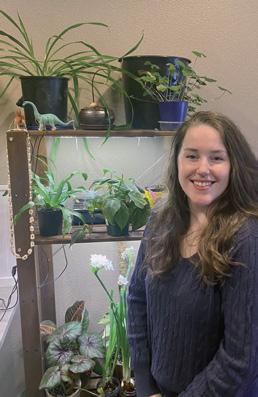
12 minute read
Measure 110 & the Roadblocks of Negative Perceptions
Countering dominant narratives that seek to reverse progress
Turn on the TV to watch the local news and you will likely see stories on gun violence, crime, dysfunction in City Hall, and the rising number of people living outdoors. Another type of story that is used to contribute to the narrative of a decaying Portland are the segments that focus on widespread drug use, drugs cut with fentanyl, or stories with a polarizing view on Oregon’s Measure 110.
Advertisement
It was in November of 2020 when the Drug Addiction Treatment and Recovery Act (Measure 110) was passed with nearly 60% of Oregonians voting in favor of the measure. Measure 110 consists of two primary purposes: to increase funding and access to treatment and recovery services, and to remove criminal penalties for the possession of small amounts of controlled substances.
Measure 110 also makes the penalties for the possession of personal and noncommercial amounts of various different controlled substances no more than a Class E violation or a maximum fine of up to $100. In lieu of the $100 fine, a person subjected to these penalties may complete a health assessment at one of the state’s designated Addiction Recovery Centers within 45 days of receiving a citation, upon which the fine will be waived.
The Drug Treatment and Recovery Services Fund receives its funding from the Oregon Marijuana Account and from money that the State of Oregon saves from the reduction in arrests and incarceration due to the implementation of Measure 110, as well as sentence reductions that are stated in the later sections of the Drug Addiction Treatment and Recovery Act.
While different sources on drug use and overdose death here in Oregon seem to have conflicting numbers and statistics, data from the CDC reveals that for 2021, Oregon had 25.4 overdose deaths per 100,000 people—well below the national average of 34.3 deaths per 100,000 people. Although Oregon overdose deaths are lower than much of the nation, the need for education and training in harm reduction—as well as increasing access to treatment and recovery programs—would only serve to help reduce the number of Oregonians that die from a drug overdose.
The challenges that need to be addressed to reduce overdose deaths are often exacerbated by dominant narratives that paint those who struggle with addiction and those who use drugs as criminals, and that the solutions required are of a punitive nature that dehumanizes people while placing them in jail.
In exploring the topic of harm reduction, I spoke with Alana from Portland People’s Outreach Project (PPOP), an all-volunteer run organization that distributes harm reduction supplies throughout the city of Portland by serving the needs of the individual and leading with compassion. PPOP’s philosophy, as stated on their website, states that “PPOP chooses to accept the reality of drug use and to humanize the people who use drugs by treating them with love and support, not anger and condescension.”
“We’re all taught this concept and idea of who these people are,” Alana says of the way the public perceives people who are houseless or who use drugs. While she didn’t enter into this work with
by Alex Aldridge
the stigmatizing view that many have of those who use drugs, her experiences counter those that commonly stigmatize and dehumanize those who do.
“It’s so much different than what you expect,” Alana says. “It’s so much different from what you’re told by everybody else, and it’s so much different than even just average people in the streets make it seem like.”
Unfortunately, the public perception surrounding those struggling with substance abuse and addiction is often created by law enforcement, local media, and politicians. These narratives have been used to undermine Measure 110 in order to create a negative perception of the measure and its effects on Oregon.
During the recent election in Oregon last November, candidates Betsy Johnson and Christine Drazan had both stated their intent to repeal Measure 110 if they were to be elected to office. While newly elected Governor Tina Kotek stated that she wouldn’t repeal Measure 110, she mirrored the other candidates’ concerns about the slow rollout in an article from OPB, saying “the state has failed to deliver the promised treatment programs fast enough.” Similar to other progressive policies passed around the country—like bail reform—Measure 110 has faced backlash since its very inception.
This backlash has contributed to the dominant narratives that convolute the general public perception of harm reduction and the criminalization of people who use drugs while ignoring the evidence and effectiveness of harm reduction and decriminalization. Ample evidence shows the harmful and ineffective punitive policies of the failed War on Drugs.
Much of the criticism aimed at Measure 110 was due to the amount of time it took for the funding to get into the hands of treatment and recovery service providers. While the decriminalization part of the measure went into effect February 1, 2021, the funding for the Addiction
Recovery Centers wasn’t distributed until September of last year—though Access to Care awarded $22.3 million in grants to 70 different organizations across Oregon in 2021. Though PPOP did receive funding as part of those grants, they weren’t a recipient of the latest amount of money distributed by the Oversight and Accountability Council of OHA.
While this lapse in time between the distribution of funds and the decriminalization drew condemnation, the predictably sluggish allocation of State funding shouldn’t detract from the decriminalization aspect of Measure 110.
It was in June of 1971 when then President Nixon declared a War on Drugs. That war has been escalated in one form or another by every subsequent president since. Not only has the drug war disproportionately impacted BIPOC communities due its roots in racism—reflected in differences in criminal sentencing between crack and powdered cocaine, mandatory minimum sentencing, and disproportionate lengths of sentencing for the same offense between white and BIPOC communities— it also destroys the lives of those same communities outside of the criminal legal system. Losing custody of children, the right to vote, and being denied access to employment, housing, student aid, and other public services are all forms of violence that are inflicted on those who are criminalized. Currently, 374,000 people are incarcerated for drug offenses on any given day, representing 20% of the overall number of people who are held prisoner in the U.S.
A 2021 poll of 800 voters that were weighted to represent national voter registration numbers, showed that 83% agreed that the War on Drugs has failed, and that 66% of voters supported the elimination of criminal penalties for possession in favor of reinvesting resources towards treatment and recovery services.
In addition to divesting from criminalization in favor of treatment and recovery services, evidence shows that organizations and groups that provide harm reduction education and supplies help prevent deaths from drug overdoses, as well as the spreading of infectious diseases.
Alana says that among the typical harm reduction supplies—such as clean syringes, pipes, and the life-saving opioid overdose-reversal medication naloxone (Narcan)—PPOP also provides gauze, bandaids, and other first aid supplies. In addition to handing out naloxone, they also do a lot of training on how to use it.
What sets PPOP apart from many other harm reduction organizations is that where other organizations do needle exchanges as a one-for-one approach— getting a clean syringe in return for handing in a dirty syringe—PPOP doesn’t require people to turn in dirty needles in order to receive a clean one in return.
“That’s something that I have found that a lot of people appreciate,” Alana says of their need-based approach. She explains how dehumanizing and uncomfortable it is for people to have to endure the time-consuming process of counting out all of their dirty needles just to receive clean ones back at one-for-one needle exchanges.
Unfortunately, harm reduction organizations such as PPOP have to face challenges stemming from the belief that providing harm reduction supplies only enables people who use drugs.
“You know, that’s a big thing that I’ve heard a lot from people that are against harm reduction,” Alana says.“You’re just encouraging addiction, you’re just encouraging this or that. The problem is that people are going to do drugs. People are going to use substances. They should have access to being as safe as possible.” cities and states that are looking at similar approaches. The nonprofit Research Triangle Institute (RTI) received a four-year grant from the foundation Arnold Ventures to conduct research on the outcome of Measure 110 here in Oregon.
An example of a challenge that PPOP and other harm reduction organizations often face played out last summer when there was a violent encounter between two houseless people at a camp that PPOP regularly provided outreach to. Despite PPOP not even being there when the incident took place, they still faced negative backlash from the housing complex in the area that wanted someone to blame for the incident by manufacturing a connection between the two.
“It really sucks because one, somebody died and that was awful for the community that they were in,” Alana says. “But the housed community there didn’t take a very compassionate approach to it—as they rarely do. They essentially started attacking PPOP for it, because they decided that PPOP was to blame, because they were the ones enabling the people to be there.”
These negative perceptions and challenges that are being faced at the local level will also have a broader effect nationally. What happens here regarding Measure 110 will have an impact on other
To gauge their community perception of how Measure 110 has impacted law enforcement and communities, RTI conducted interviews with 34 representatives from law enforcement, emergency and medical services, district attorney offices, and harm reduction and treatment communities in four distinct areas of Oregon during the summer last year. RTI also looked at publicly available 911 dispatch data for the cities of Portland, Seattle, Boise, and Sacramento from January 2018 to July 2022 to compare 911 call data in Portland with three other cities in the region before and after the implementation of Measure 110.
Not only did the summary of their initial findings show that 911 call data for Portland tracked similarly to the other three cities in seasonal fluctuations and without any spike of calls after the decriminalization aspect of Measure 110 took effect, but their findings also show that the data ran counter to the negative perceptions that the 34 interview participants had concerning Measure 110.
After noting that 20 of the 34 interviewees were law enforcement officials in an article in the Oregon Capital Chronicle, Lynne Terry wrote that “police officials told the RTI researchers that their jobs have become more difficult since Measure 110 went into effect in early 2021.” According to her, RTI epidemiologist and researcher Alex Kral asserts that people and the media have talked a lot about increases in crime due to Measure 110, despite their data showing otherwise. And although the law enforcement officials who were interviewed believe that drugs have created a spike in property crime, the 911 call data doesn’t reflect their sentiments.
Though RTI only has the data collected from the 911 calls and the interviews at this stage of their study, the gap between the perception and reality that law enforcement and other legal system representatives possess in reference to Measure 110 reflects the obstacles that are faced when attempting to move away from the punitive approaches that have been the status quo for so long. When data on crime is questionable to begin with due to it being reported and controlled by the very institutions that benefit from that data, adding these detached perceptions into the mix creates narratives of fear that cause more harm to the public than the harm they are claiming to address.
In speaking about Measure 110 and the doubts that were cast from before it was even implemented to now, Alana challenges the narratives that claim Measure 110 hasn’t accomplished anything.
“We’ve only had a few months with everybody being able to get funding. And it takes a while to build structures and community and trust within the community,” she says.
There will be growing pains of course. She notes that while PPOP has been doing this work for over ten years, it will take time for other organizations to build the same amount of trust with those in the community. Part of PPOP’s success is that in addition to being 100% volunteer run, those with lived experiences are often placed at the front, an essential approach that is often forgotten by many organizations that claim to work with the community.
Organizations like PPOP that center the individual and their needs by leading with compassion and trust are essential to the entire community, and will only become more important as dominant narratives push to establish the negative perceptions of both Measure 110 and of people who use drugs and those who are struggling with addiction. Information on how to volunteer or donate to PPOP can be found at portlandpeoplesoutreach.org.
A solumn lampost stands alone at a crossroads. Portland's mossy conifer trees obscure what lies ahead.

photography by jaden quayle
Green Friend For Mental Health Researched By
psu student brittani wallsten
by leeann rooney
Ever consider surrounding yourself with lush green foliage? Think Adam and Eve, think FernGully, think Plantopia, and now you have the picture of the life of PSU Psychology student, Brittani Wallsten. Wallsten surrounds herself, and her partner, with an abundance of living, growing, oxygen-generating plants. She loves plants and the joy they bring her, so when she was given the assignment to do a qualitative research project for her Urban Social Sciences class, it was only natural for her to choose a plant-related topic.
Wallsten moved to Portland three years ago from California. She has long brown hair with wavy curls cascading down, and when she smiles, you have to smile with her. She is a senior and will graduate soon with a psychology degree and a minor in neuroscience.
Wallston had already begun raising and caring for plants as a COVID-related coping mechanism for herself.
“I killed most of my plants in the first year of having them because I didn’t know what I was doing at all, and now I have like thirty or forty of them that I am keeping alive,” she said.
It was a learning curve.
Her research question asked what the mental health benefits of having houseplants in one’s dorm during the COVID lockdown were. Wallsten looked into four metrics: aesthetics, routine, positive responsibility, and using houseplants to indicate one’s health status. At the time of her research, the campus was sparsely populated, as most students left and continued to learn remotely. Only a few brave souls remained in the dorms, and those that remained were separated—one per room and just a few per floor. Wallsten empathized with these students, coming to a new city expecting the typical college experience and then being isolated.
For her research, Wallsten interviewed four students and also hosted a focus group. The data that came out of this qualitative report might not be hugely surprising, but just the same, it was very thoughtful, clear, and novel.
As stated in Wallsten’s article, Houseplants were found to support students’ mental health by encouraging a regular routine, providing opportunities for responsibility, adding aesthetic value, and serving as a general indicator of mental health. Plants encourage a regular and timely routine which is a good thing for anyone, providing responsibility and moving past a sense of self-absorption.
“There is a term, accidental narcissism, when you are so focused on your inner world that you have a hard time reaching out and connecting with other people,” Wallsten explained. Having something small that pulls you out of yourself, like pay attention to this tiny little spider plant for five minutes. That can start building this momentum of pulling you out of that deep dark place.
For example, Wallsten said, “you would have folks that are really struggling with intense depression or psychosis or whatever, and then just in the middle of a conversation, they will be like, ‘that looks nice, today.’ She said the plant would actually pull people out of their heads into a “tangible, practical, beautiful thing.”
A warning after all these lovely houseplant miracles for mental health: please don’t rush out and buy all of your friends a plant gift.
"If anyone were to give me a plant, I would be over the moon,” Wallsten said. But she went on to inform that just as you would not give a living animal as a gift it is also not wise to give a houseplant as a gift. Some may not enjoy the added responsibilities of taking care of a living thing and if the plant were to expire this might even add to their stress and feelings of incompetence.
“It was interesting to get those mixed perspectives in the group,” Wallsten said.
In addition to being a full-time student, Wallsten works at a residential mental health treatment home. And if that is not enough, she also works in a Legacy Health neuroscience research laboratory. After graduation, Wallsten hopes to enter OHSU psychiatric mental health nurse practitioner program. She said she would like to “continue in mental health, more of a medical avenue than I have been.”
As Wallsten reports in her article, this study brought answers, but also more questions.
Wallsten’s article titled Houseplants as Mental Health Supports for Dorm Occupants During the Lockdown Period at Portland State University can be found in Vol 11 (2022) of ANTHOS (the undergraduate research journal).







